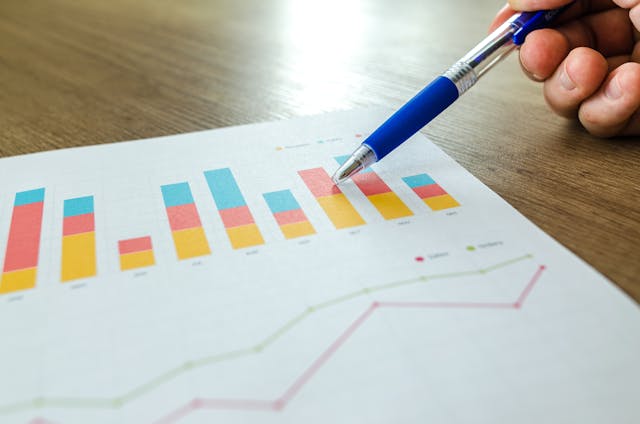20 Jun, 2024 • 7 min read
Click-Through Rate (Ctr) Vs Conversion Rate: Definition, Formula, Calculation

You’re looking to understand the difference between Click-Through Rate (CTR) and Conversion Rate, two essential metrics for online advertising campaigns. CTR measures the percentage of people who click on an ad after seeing it, while Conversion Rate tracks the percentage of website visitors who complete a desired action. To calculate CTR, divide the number of clicks by the number of impressions and multiply by 100. For Conversion Rate, divide the number of conversions by the number of visitors and multiply by 100. By understanding and optimizing these metrics, you’ll be able to refine your marketing strategy and drive more sales. Now, let’s dive deeper into the formulas and strategies behind these metrics.
Contents
- 1 What is click-through rate?
- 2 Why are click-through rates important?
- 3 What’s the formula for click-through rates?
- 4 What is conversion rate?
- 5 Why are conversion rates important?
- 6 How do you calculate conversion rates?
- 7 Conversion rate vs. Click-through rate: which one should you measure?
- 8 6 actionable growth tactics for improving click-through rates
What is click-through rate?
What is Click-Through Rate?
When you see an ad or a link online, do you click on it? The percentage of people who click on a link or ad after seeing it’s called the click-through rate (CTR).
Why is CTR important?
CTR is crucial in digital marketing because it shows how well your ad or link is performing. A high CTR means your ad is relevant and appealing to your target audience. A low CTR means you need to make improvements.
How to Optimize CTR?
To increase your CTR, focus on these user engagement strategies:
- Craft compelling ad copy
- Use eye-catching visuals
- Target the right audience
Why are click-through rates important?
Why Click-Through Rates Matter
Click-through rates are crucial in digital marketing because they directly impact the success of your advertising campaigns. They measure how well your ads resonate with your target audience.
A high click-through rate means your ads are relevant, engaging, and well-placed, leading to more conversions and a higher return on investment.
What Affects Click-Through Rates?
- User Engagement: If your ads don’t capture users’ attention, they’ll likely ignore them or scroll past them. Well-crafted ads that resonate with users can lead to higher click-through rates, increased brand awareness, and more conversions.
- Ad Placement: Ads placed in high-traffic areas or alongside relevant content can greatly boost click-through rates.
Why You Should Care
By tracking click-through rates, you can:
- Identify areas for improvement
- Refine your targeting
- Optimize your ad copy to better resonate with your audience
Understanding the importance of click-through rates helps you refine your advertising strategy, improve user engagement, and drive more conversions.
What’s the formula for click-through rates?
The formula for calculating the click-through rate is:
You calculate the click-through rate by dividing the number of clicks on an ad by the number of times the ad is shown, and then multiplying the result by 100. This gives you a percentage that shows how effective your ad is at grabbing users’ attention.
Here’s how to do it:
- Number of clicks: Count how many times users click on your ad.
- Number of impressions: Count how many times your ad is shown to users.
- Division: Divide the number of clicks by the number of impressions.
- Multiplication: Multiply the result by 100 to get the click-through rate percentage.
What is conversion rate?
What is Conversion Rate?
Conversion rate measures the percentage of website visitors who take a desired action, like making a purchase, filling out a form, or subscribing to a newsletter. As a marketer, you want to know how many of your website visitors are doing what you want them to do. This metric is super important in figuring out if your marketing campaign or website is working well.
How to Calculate Conversion Rate
To calculate conversion rate, you divide the number of conversions by the number of visitors, and then multiply by 100. For example, if your website has 100 visitors and 10 conversions, your conversion rate is 10%. A high conversion rate means your website is really good at turning visitors into customers.
Improving Conversion Rate
To improve your conversion rate, you need to focus on conversion rate optimization (CRO) strategies. This involves:
- Testing and refining various elements like landing pages, forms, and calls-to-action to enhance user engagement.
- Making changes to increase user engagement and convert more visitors into customers.
By using effective CRO strategies, you can increase your conversion rate and drive more sales and revenue.
Why are conversion rates important?
Why Conversion Rates Matter
Measuring conversion rates is crucial because it helps you see if your marketing campaign or website is doing its job – turning visitors into customers.
By tracking conversion rates, you can find areas to improve and make your marketing strategy better to increase user engagement and drive more sales.
Four Key Reasons to Care About Conversion Rates
- Marketing Effectiveness: Conversion rates show if your marketing campaigns are working or not, and what needs improvement.
- User Engagement: A high conversion rate means your website or campaign is engaging users and making them take action.
- Return on Investment (ROI): Tracking conversion rates helps you calculate the ROI of your marketing campaigns and spend your budget wisely.
- Data-Driven Decisions: Conversion rates give you valuable insights to inform your marketing decisions and optimize your strategy for better results.
How do you calculate conversion rates?
How to Calculate Conversion Rates
To calculate conversion rates, you need to divide the number of conversions by the number of visitors, and then multiply by 100. This gives you a percentage that shows how well your website or marketing campaign is doing in achieving its goal.
The Formula:
- Number of conversions ÷ Number of visitors = Conversion rate
- Multiply the result by 100 to get a percentage
Example:
Let’s say your website has 100 visitors and 10 conversions. To calculate the conversion rate:
- 10 conversions ÷ 100 visitors = 0.1
- Multiply by 100: 0.1 x 100 = 10%
This means your conversion rate is 10%. This metric is crucial in conversion rate optimization, as it helps you identify areas for improvement in your website analytics.
Conversion rate vs. Click-through rate: which one should you measure?
Conversion Rate vs. Click-through Rate: Which One Should You Measure?
When evaluating the success of your marketing campaigns or website, you’re likely wondering which metric to focus on: conversion rate or click-through rate.
Why Measure Both?
- Conversion Rate: This measures the percentage of visitors who complete a desired action, such as making a purchase or subscribing to a newsletter.
- Click-through Rate: This measures the percentage of users who click on an ad or link after seeing it.
Why Measurement Matters
Comparing these two metrics is essential to understand the effectiveness of your marketing campaigns and website. This helps you assess the impact of your marketing strategies and make informed decisions to optimize them.
6 actionable growth tactics for improving click-through rates
Improve Your Click-Through Rates with These 6 Tactics
Want to drive more traffic to your website? You can do it by improving your click-through rates. Here’s how:
Tactic 1: Craft Compelling Ad Copy
Use clear and compelling headlines that highlight the benefits of your product or service. This will get users engaged and increase the chances of them clicking on your ad.
Tactic 2: Grab Attention with Visuals
Use eye-catching images or videos to grab users’ attention. This will make them more likely to click on your ad.
Tactic 3: Target the Right Audience
Use demographic targeting, interest targeting, or behavioral targeting to ensure your ad reaches the right people.
Tactic 4: Retarget Users
Target users who’ve visited your website but haven’t converted yet. This will encourage them to come back and take action.
Tactic 5: Leverage Social Media
Use social media to promote your product or service and drive traffic to your website.
Tactic 6: Use Email Marketing
Use email marketing to promote your product or service and drive conversions.

Ankur
Ankur, with over 20 years of expertise, simplifies the complex world of online marketing to boost your conversion rates. He shares actionable insights that anyone can apply to see immediate results. Trust Ankur to guide you through proven strategies that enhance your online presence and profitability.
Related Blogs

By Ankur • 9 min read
7 A/B Testing Examples to Bookmark
You're about to discover seven A/B testing examples that drive real results, but first, let's get one thing straight: understanding statistical significance is key to...

By Ankur • 9 min read
A/B Testing Significance Calculator Spreadsheet in Excel
You can calculate the statistical significance of your A/B testing results using a spreadsheet in Excel, allowing you to confidently determine whether your variations are...

By Ankur • 8 min read
What Is Multi-Armed Bandit (Mab) Testing? | Feedify
You're using Multi-Armed Bandit (MAB) testing to dynamically allocate traffic to the best-performing versions, maximizing conversions and optimizing metrics, especially in high-traffic scenarios where every...
